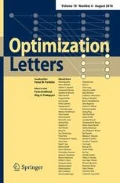Abstract
This short paper describes a simple subgradient-based techniques for deriving bounds on the optimal solution value when using the ADMM to solve convex optimization problems. The technique requires a bound on the magnitude of some optimal solution vector, but is otherwise completely general. Some computational examples using LASSO problems demonstrate that the technique can produce steadily converging bounds in situations in which standard Lagrangian bounds yield little or no useful information. A second set of experiments establishes a proof of concept indicating the potential practical usefulness of the bounding technique.


Similar content being viewed by others
References
Boland, N., Christiansen, J., Dandurand, B., Eberhard, A., Linderoth, J., Luedtke, J., Oliveira, F.: Combining progressive hedging with a Frank–Wolfe method to compute Lagrangian dual bounds in stochastic mixed-integer programming. SIAM J. Optim. 28(2), 1312–1336 (2018)
Boyd, S., Parikh, N., Chu, E., Peleato, B., Eckstein, J.: Distributed optimization and statistical learning via the alternating direction method of multipliers. Found. Trends Mach. Learn. 3(1), 1–122 (2011)
Dettling, M., Bühlmann, P.: Finding predictive gene groups from microarray data. J. Multivar. Anal. 90(1), 106–131 (2004)
Duarte, M.F., Davenport, M.A., Takbar, D., Laska, J.N., Sun, T., Kelly, K.F., Baraniuk, R.G.: Single-pixel imaging via compressive sampling: building simpler, smaller, and less-expensive digital cameras. IEEE Sig. Proc. Mag. 25(2), 83–91 (2008)
Eckstein, J., Bertsekas, D.P.: On the Douglas–Rachford splitting method and the proximal point algorithm for maximal monotone operators. Math. Program. 55(3), 293–318 (1992)
Eckstein, J., Yao, W.: Understanding the convergence of the alternating direction method of multipliers: theoretical and computational perspectives. Pac. J. Optim. 11(4), 619–644 (2015)
Fortin, M., Glowinski, R.: On decomposition-coordination methods using an augmented Lagrangian. In: Fortin, M., Glowinski, R. (eds.) Augmented Lagrangian methods: applications to the numerical solution of boundary-value problems, studies in mathematics and its applications, vol. 15, pp. 97–146. North-Holland (1983)
Gabay, D.: Applications of the method of multipliers to variational inequalities. In: Fortin, M., Glowinski, R. (eds.) Augmented Lagrangian methods: applications to the solution of boundary value problems, studies in mathematics and its applications, vol. 15, pp. 299–331. North-Holland (1983)
Gade, D., Hackebeil, G., Ryan, S.M., Watson, J.P., Wets, R.J.B., Woodruff, D.L.: Obtaining lower bounds from the progressive hedging algorithm for stochastic mixed-integer programs. Math. Program. 157(1), 47–67 (2016)
Lichman, M.: UCI machine learning repository (2013). URL. http://archive.ics.uci.edu/ml
Rockafellar, R.T.: Convex analysis, vol. 28. Princeton Mathematical Series. Princeton University Press, Princeton, N.J. (1970)
Rockafellar, R.T., Wets, R.J.B.: Scenarios and policy aggregation in optimization under uncertainty. Math. Oper. Res. 16(1), 119–147 (1991)
Tibshirani, R.: Regression shrinkage and selection via the lasso. J. R. Statist. Soc. Ser. B 58(1), 267–288 (1996)
Acknowledgements
The author would like to thank Patrick Johnstone and Paulo J.S. Silva for some discussions relating to the LASSO example.
Author information
Authors and Affiliations
Corresponding author
Additional information
Publisher's Note
Springer Nature remains neutral with regard to jurisdictional claims in published maps and institutional affiliations.
This work was supported in part by NSF grant CCF-1617617, Computing and Communications Foundations, CISE directorate, and Air Force Office of Scientific Research (AFOSR) grant FA95550-15-1-0251.
Rights and permissions
About this article
Cite this article
Eckstein, J. Deriving solution value bounds from the ADMM. Optim Lett 14, 1289–1303 (2020). https://doi.org/10.1007/s11590-020-01584-1
Received:
Accepted:
Published:
Issue Date:
DOI: https://doi.org/10.1007/s11590-020-01584-1



